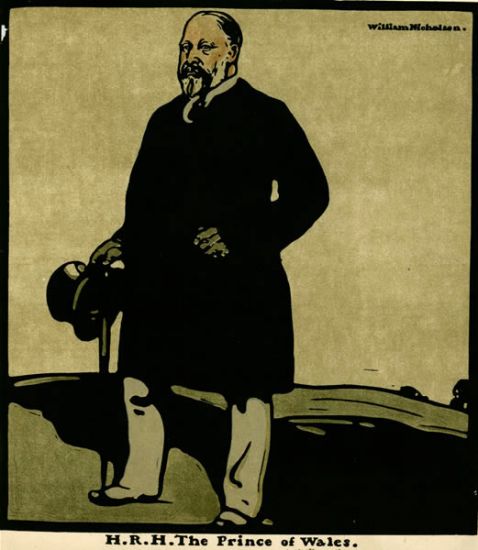
H.R.H. The Prince of Wales
Unmounted (ref: 2619)
Lithographic reproduction of a hand-coloured woodcut, 10 x 9 1/8 in. (25.4 x 23 cm.)
Tags: William Nicholson lithograph woodcut portraits Welsh Artists and Pictures

Lithographic reproduction of a hand-coloured woodcut, 10 x 9 1/8 in. (25.4 x 23 cm.)
Tags: William Nicholson lithograph woodcut portraits Welsh Artists and Pictures
Published by William Heinemann 1899 (September).
Provenance: The William Heinemann Archive 2004
The seven
portraits published in the New Review had been on sale since 1897 in the
form of individual lithographic reproductions of the original
hand-coloured woodcuts. In 1899, the portraits commissioned to make up
the Twelve Portraits set (the
Prince of Wales, W, E. Gladstone, the Archbishop of Canterbury, Sir
Henry Hawkins and Sir Henry Irving) were also offered for sale in this
form. An advertisement in the 14 December 1901 issue of the Athenaeum
reveals that these lithographic reproductions were sold at 2s 6d each
(see 'Mr Heinemann's Christmas List').
The Twelve Portraits series
was published in September 1899 in two editions: a portfolio of
hand-coloured woodcuts and a portfolio of lithographic reproductions
mounted ready for framing. The majority of the prints had initially been
conceived as individual works, and it was expedience alone that brought
them together in a set; but the series in its published form is not
without homogeneity. Certainly it fulfilled its aim of portraying a
representative selection of the most notable men and women of the day.
`A few years hence,' claimed a reviewer in the 9 December 1899 issue of Literature, `Mr Nicholson's portfolio of Twelve Portraits ... will be of undoubted historical value.' Perhaps this was going too far, but mans- critics believed that Twelve Portraits contained Nicholson's best work, and indeed it was this series that was to earn the artist a gold medal at the Exposition Universelle in Paris in 1900.
Early
in 1901 a second series of 12 portraits was proposed. Heinemann sent
Nicholson a list of suggested sitters in July, but work on the project
proceeded very slowly and it was not until the summer of 1902 that the
portraits were finally delivered. Nicholson, always ready to re-use
existing material, commandeered his Lord Kitchener (1898) and William 11
(1899) for this series (the latter was published in a slightly revised
form), and also made use of studies of Thomas Edison, Theodore Roosevelt
and Mark Twain made in New York in the autumn of 1900. The remaining
seven portraits were conceived and executed in 1901/2: Queen Alexandra
[104], Joseph Chamberlain (Colonial Secretary at the time of the Boer
War), Li-Hung Chang (the Chinese statesman), Henrik Ibsen (whose plays
Heinemann published in English translations), Sada Yacco (the Japanese
actress who modelled for Rodin) [20], E/eonora Dose (the great Italian
tragedienne), and Pope Leo XIII.